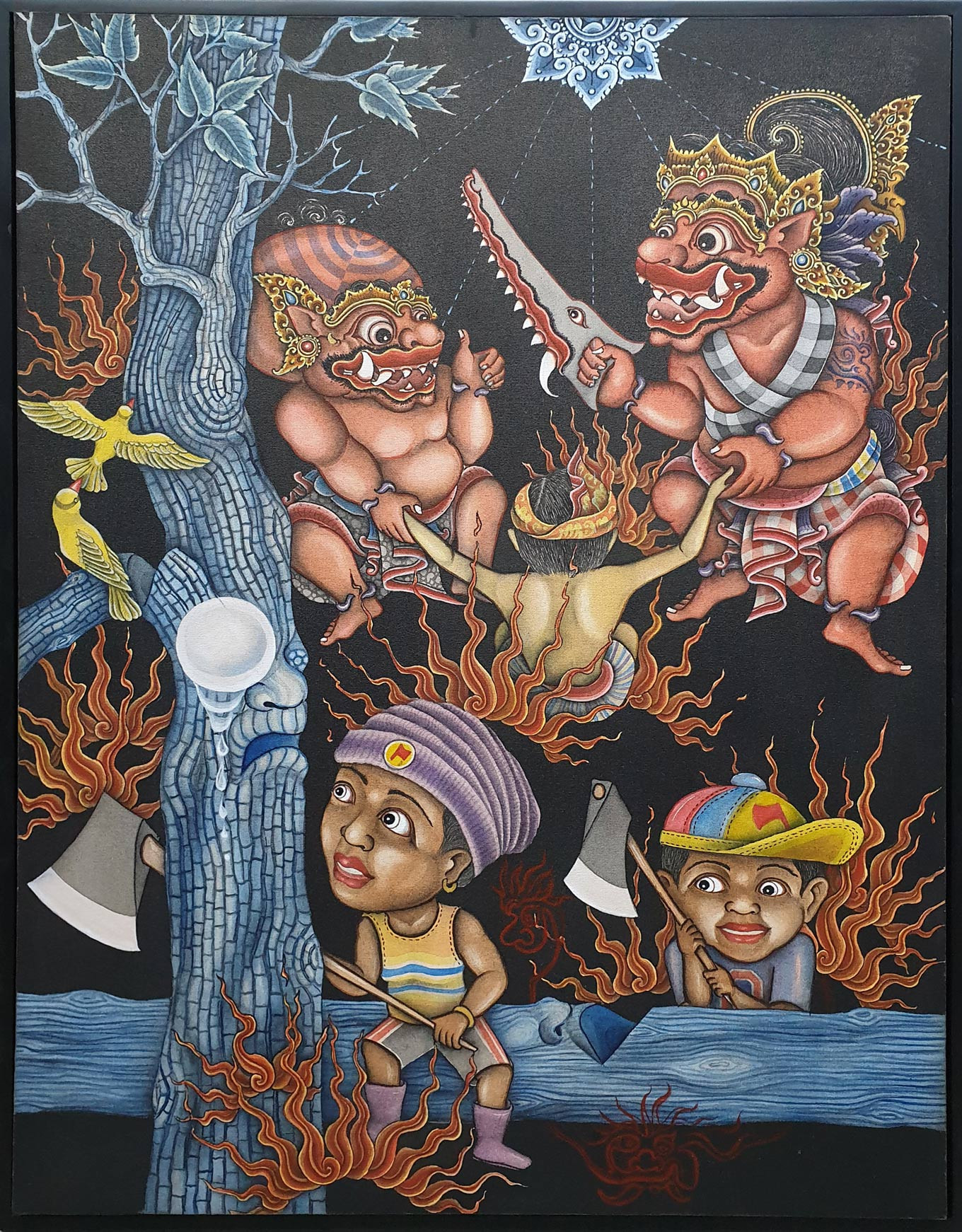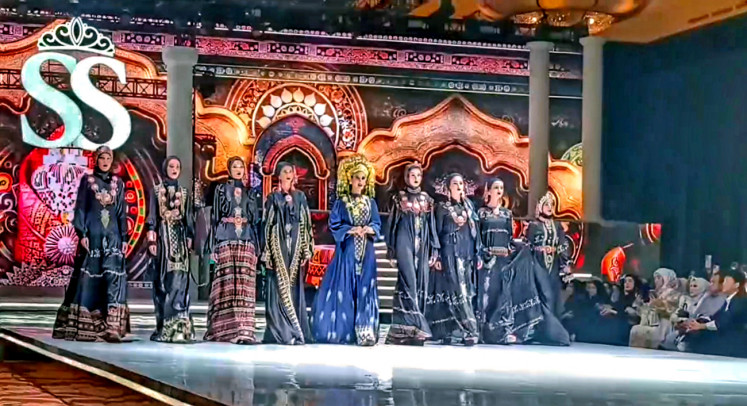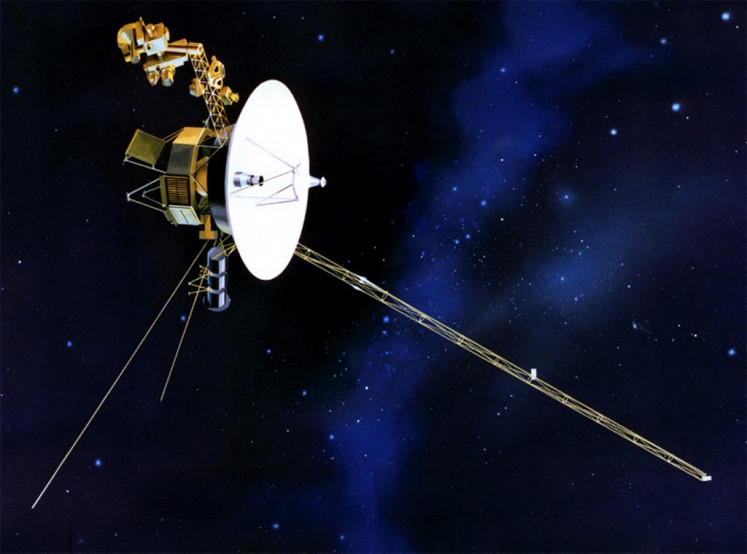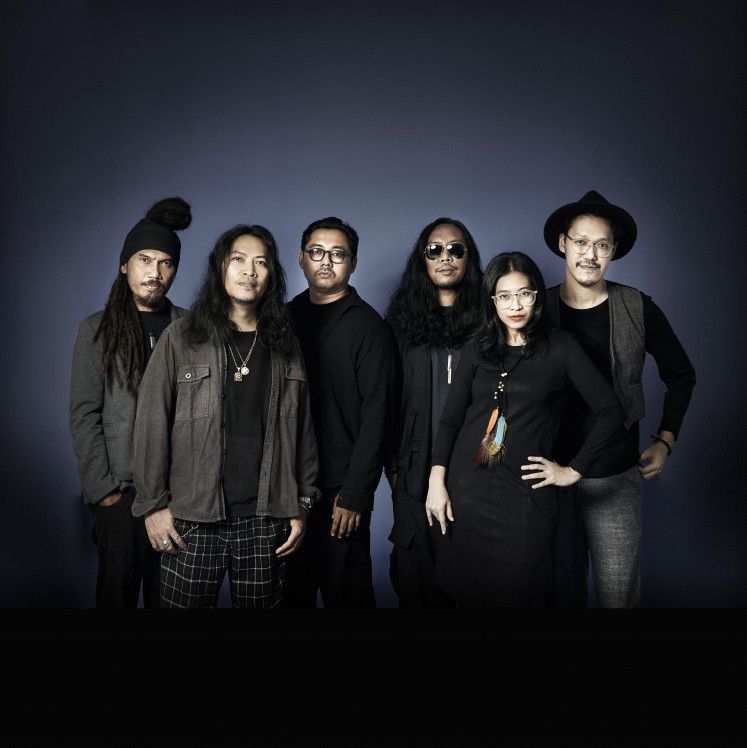Made Sujendra's fantastic, light-hearted depictions of the underworld
Hell Sign, a solo exhibition of paintings by I Made Sujendra, opened on Dec. 1 at TiTian Art Space in Ubud.
Change Size
 "Senyummu Tangisku" by Made Sujendra (JP/Richard Horstman)
"Senyummu Tangisku" by Made Sujendra (JP/Richard Horstman)
I
n Klungkung, East Bali, the former capital of the island, stands Kerta Gosa, an 18th century mandala shaped pavilion within the royal palace built by the monarch Dewa Agung Gusti Sideman. It functioned until 1908 as the kingdom’s court of law and justice.
Its ceilings are adorned with paintings from a Hindu Mahabharata epic, in the classical Balinese narrative style featuring wayang characters derived from the shadow puppet theater. Scenarios describe divine retribution for law-breakers, one scenario depicts the afterlife fate of being cooked alive in cauldrons of boiling water by the ogres of hell.
The paintings served as teaching modalities promoting good moral behavior and peace within Balinese society, and they are a source of inspiration behind Hell Sign, a solo exhibition of paintings by I Made Sujendra that opened on Dec. 1 at TiTian Art Space, Ubud.
“Balance is the key to life according to the Balinese and when this is forsaken during the afterlife we will be subjected to dire consequences according to karmic laws,” Sujendra said.
“My paintings are stirred by my observations of life, and what is necessary for us to learn in order to live harmoniously, and ultimately avoid the cycle of reincarnation.”
“In my search for a new style within the framework of the Batuan techniques I moved away from the conventional crowded and complex compositions,” said Sujendra, who is considered an outsider within the Batuan School of Balinese traditional art. “I experimented with simpler, more minimal configurations that balance empty space with iconography in order to create a fresh and strong aesthetic impact.”
Lineage and the master-pupil relationship have played an important role in the development of Batuan painting, the most critically acclaimed genre of Balinese traditional art.
Born in 1964, Sujendra is the son of accomplished painter Wayan Kabetan, who was a student of iconic Batuan modernist innovator Nyoman Ngendon (1906-1946). The Greedy Priest, Sujendra’s landmark 1984 painting, was featured in Dr. Jelantik’s 1990 book Balinese Art, after which he was labelled the original "surrealist" of the Batuan School.
Sujendra pioneered imagery and compositional structure in the mid 1980s that more recently has become one of the catalysts in an exciting revival in the Batuan School, led by a new generation of emerging painters like Ari Sarmanta, Wayan Budiarta and Pande I Made Dwi Artha.
Exploring life choices and the karmic consequences we are subjected to in the hereafter according to ancient Balinese beliefs, Sujendra’s themes include lust, adultery, greed, abortion and reincarnation. In Kerja (Work, 2018) Sujendra describes the afterlife scenario for those who have chosen a lazy and idle earthly existence. The payback is an eternity in hell as a beast of burden. Men are tethered to ploughs being whipped by demons, balls of fire explode with every stroke of their whips. With bodies large and rotund, their faces depict anguish and dismay.
Senyummu Tangisku (Your Smile is My Tears, 2018) reveals two child-like characters cutting down trees. One offender is receiving retribution – restrained by two of hell’s guardians, one giving the thumbs up and expressing delight, while the other cuts open the wrongdoer’s head with a sharp tooth saw.
For those who venture into the forest and shoot the wildlife without restraint, Berburu & Diburu (Hunters & the Hunted, 2018) reveals hunters surrounded by a bevy of angry animals and demons. The afterlife scenario depicts the hunters being hunted by the very creatures they once pursued.
And while Sujendra’s colorful and black and white compositions are indeed confronting, they are, however, defined by his sense of humor. His demonic creatures are at once serious, yet playful, exuding both horror and charm – his ogres appear as lovable "clowns".
Eleven paintings and two installations are featured in Hell Sign. Eight paintings are grouped together and presented as an installation that includes a large, flowing minimal red line mural of demonic creatures painted upon the gallery floor. The area has been cordoned off so that onlookers do not enter the space to closely inspect the works. They are forced to observe the group of paintings as a whole, and as a painting installation, from a distance.
“Exhibitions are about communication, and not only just display,” said TiTian Art Space founder Soemantri Widagdo.
Read also: I Nyoman Ngendon: Between paintings and bullets
Since its inception in the Balinese art landscape in January 2015, TiTian has set out to reconfigure the norms that have hindered the local art gallery model. In Hell Sign, TiTian pushes the boundaries of exhibition design and presentation so that the local art audience has an opportunity to experience traditional art within a new framework, in a fresh and exciting manner.
“We strive to be at the leading edge of presenting art to the public, and we will push the boundaries using innovative exhibition design principles,” stated Widagdo. “Beyond our trademark of exhibiting only nine paintings, we wish to introduce a new language in communicating ideas behind the artworks. We will explore installation concepts as our trademark rather than just a collection of hung paintings.”
A schoolteacher for the past two decades, Sujendra is well aware of the younger generation’s attraction to the imagery of the digital era. For them, the Kerta Gosa paintings have lost their potency and appeal and a new aesthetic code is required. Sujendra’s renderings of the Balinese legends and folklore, however, are a proven language, and already a source of inspiration for the emerging artists of Batuan.
______________
Hell Sign continues until Jan. 30, 2019
TiTian Art Space
88 Jalan, Bisma, Ubud, Ginayar, Bali
Open Tuesday – Sunday 9am to 5pm









